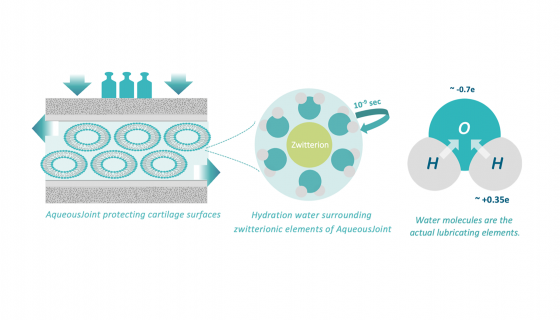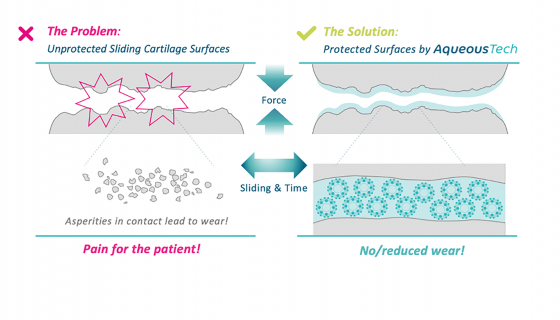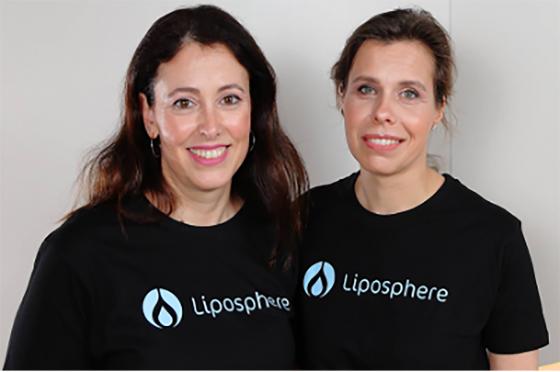ATiO Award Winner 2023: Liposphere Ltd
"Congratulations to Liposphere Ltd. for emerging as the victorious company among a pool of 14 exceptionally promising contenders in the Early-Stage Company Contest at the ATiO Conference 2023!
Liposphere Ltd. stands at the forefront of innovation as a biomedical start-up hailing from Israel, with the distinction of being founded and led by a dynamic team of women. Their journey began with a spinout from the prestigious Weizmann Institute of Science in early 2019, and since then, they've made remarkable strides in the world of technology and medicine.
At the heart of Liposphere's success lies their groundbreaking platform technology, AqueousTech. This unique creation has redefined the possibilities of water-based biolubricants, delivering unparalleled ultra-low friction and highly efficient lubrication across various medical and technological applications. With a keen focus on the orthopaedic and ophthalmic sectors, Liposphere is setting new standards driven by market insights and demand." – ATiO Foundation
Liposphere Ltd
Liposphere (www.lipo-sphere.com) is an innovative, female-led biomedical start-up spun out from the Weizmann Institute of Science/Israel in 2019. The Company has been led by former academic scientists Ronit Goldberg and Sabrina Jahn since its inception. Originating from academic work, Liposphere has developed a unique patent-protected platform technology of unmatched, water-based boundary lubricants for orthopaedic applications. These boundary lubricants perform extremely well under high pressures and loads, hence making them ideal candidates to be developed for the orthopaedic medical sector. The main product under development – AqueousJoint - is a local knee joint injectable for treating Osteoarthritis (OA).
Osteoarthritis is a painful chronic joint condition that affects more than 500 million people[1-2] with an annual growth of over 8%[3]. There has been no non-surgical treatment that can effectively prevent or even delay OA progression. Due to the lack of available curative therapies, the current standard of care focuses on pain management in the period before a patient becomes eligible or opts for knee replacement surgery. Pain is typically treated with anti-inflammatory therapies via both, the oral and intra-articular (IA) routes. IA injections pose an attractive strategy to target the affected tissue while minimizing adverse side effects. The two existing main injectable solutions are corticosteroids and viscosupplementation using Hyaluronic Acid. IA corticosteroid injections provide effective short-term pain relief; however, these effects are limited by the short half-life of the compound in the joint and the subsequent relatively brief duration of anti-inflammatory and analgesic effects. Hyaluronic Acid provides viscous mechanical support to the synovial fluid of the joint capsule, aiming to achieve temporary pain relief. Different Hyaluronic Acid commercial products are technologically similar and may only be differentiated by the exact molecular weight and excipient solution formulations’ ingredients. The efficacy of IA-HA treatment for knee OA is a controversial topic, particularly among the orthopaedic community, as the current literature provides inconsistent results and conclusions regarding this treatment method. Due to the lack of thorough analysis and high-quality reporting regarding the use of IA-HA, a poor evidence base exists for the treatment.
Unlike hyaluronic acid-based products, which aim to increase the viscosity of the synovial fluid, AqueousJoint acts on the cartilage surface by forming a robust, long-lasting mechanical coating that protects cartilage from wear-related pain. AqueousJoint has shown promising First-In-Human (FIH) clinical results: AqueousJoint is safe; no serious adverse events or related adverse events were reported in the FIH clinical trial. The trial demonstrated immediate (within days) pain reduction and improvement in the patient’s ability to perform daily activities and sports. The benefits of a single AJ injection lasted throughout the entire FIH study period of 6 months.
AqueousJoint is a liposomal formulation that does not incorporate any active pharmaceutical ingredient but instead acts as a pure lipid-based boundary lubricant on the cartilage surface while sliding under articulation. The elastic liposomal spheres are compressed and de-compressed during confinement. The unique lubrication performance of the product at orthopedically relevant high pressures is greatly dependent on the morphological, spherical structure of the individual liposomes on the cartilage surface. This is because the bilayers forming the liposome membrane are essentially defect-free – in contrast to bilayers in the lamellar phase - even when the liposomes are compressed and sheared, and so provide a lubricating layer of high integrity. A crucial element to allow for morphological stabilization and effective lubrication is the integration of a unique lipid-polymer entity, which Liposphere has developed and integrates during the manufacturing of the liposomes. This lipid-polymer entity makes use of the idea that certain zwitterionic groups hold hydration water extremely efficiently and create hydration hotspots throughout the AqueousJoint liposome.
The formation of hydration layers around the AqueousJoint liposomes enables a highly efficient reduction of frictional forces at the slip plane between opposingly coated cartilage surfaces via the Hydration Lubrication Mechanism[4-7], a revolutionary concept which forms the core of Liposphere’s technology:
The concept of hydration lubrication as a paradigm for the reduction of friction in aqueous media has been discovered by Raviv et al./Briscoe et al[4-7]. With respect to the mechanism, the hydration shells are tightly trapped and, as a result, their spatial overlap is strongly resisted, leading to repulsion between the hydrated zwitterionic groups, so-called hydration repulsion which is essentially a steric effect. At the same time, the exchange rate of water molecules in the hydration shell with water in the surrounding bulk is very rapid (up to 109/s), leading to rapid relaxation of the layer and thus a fluid-like behaviour under shear/articulation. This combination means that it is difficult to squeeze the hydration water surrounding the phosphocholine groups of the product out under compression of the cartilage surfaces but that, when sliding, as the joint articulates, the hydration shells are rather fluidic, and the surfaces slide easily past each other.
This combination of sustaining high loads together with easy sliding thus results in very low friction. Ma et al.[8] studied the origin of hydration lubrication and showed directly that the mechanism was essentially identical to that of oil trapped between sliding surfaces. In simple words, the ultrathin-bound hydration layers exposed at the outer surfaces of our liposomes behave in the same way as a lubricating ‘oil’ and account for the substantial reduction in friction via the hydration lubrication mechanism determining the primary mode of action of the AqueousJoint product. Image 1 illustrates the mechanism schematically.
AqueousJoint as a purely mechanically acting boundary lubricant is anticipated to be classified as a medical device from a regulatory perspective. Liposphere focuses on the commercialization route to market in Europe first. The Company is currently expanding its clinical trials: a multi-centred, double-blinded clinical trial involving 150 patients with a focus on efficacy is ongoing at three different clinical sites in Israel (https://www.clinicaltrials.gov/study/NCT05771948?distance=50&term=Lipos…). Moreover, Liposphere plans to begin a clinical trial in Germany in 2024. The Company built its own small production site in Central Israel to manufacture clinical batches under ISO-certified regulation in-house. There are currently 25 FTE employees working at Liposphere with more than 60% of the employees being women. An incredibly powerful team to move the technology closer to the market! Liposphere intends to expand its manufacturing capability to serve the European market following an investment round in early autumn 2023. While the company aims to keep the manufacturing in-house, sales and distribution will be managed via external commercial parties.
AqueousJoint’s technology is not limited to an application in the knee joint only. The Company aims to provide a solution for other human joints in the future but is also looking to explore the veterinary market with an interest in providing relief and improvement in joint functionality for dogs and horses. Furthermore, there is potential to work with an established industry partner to develop the first combined lubrication/API delivery vehicle based on the product's encapsulation capability as a liposome.
The Author
The company's co-founders, Dr. Ronit Goldberg (CEO) and Dr. Sabrina Jahn, bring a wealth of experience, having collaborated in Prof. Klein's academic setting for several years before embarking on their entrepreneurial venture. Their journey is supported by the Israeli Innovation Authority and a consortium of highly experienced private investors, exemplifying the power of collaboration between academia and industry.
Notably, Liposphere's excellence has garnered recognition on an international stage, with the Spinoff Prize 2020, organized by Nature in partnership with Merck KGaA, showcasing them as one of the 44 most exciting, science-based firms to emerge from academic environments. They are indeed a "One to Watch" in the realm of innovation.
Once again, congratulations to Liposphere Ltd. for their outstanding achievement, and we look forward to witnessing their continued success as they shape the future of biolubricants and biomedical technology.
Liposphere's journey is backed by a wealth of knowledge, including the Hydration Lubrication Mechanism, an extraordinary discovery developed over two decades at the Department of Materials & Interfaces, Weizmann Institute of Science. Holding exclusive IP licenses for this technology, Liposphere has carved a niche for itself in the industry.
Notably, Liposphere's excellence has garnered recognition on an international stage, with the Spinoff Prize 2020, organized by Nature in partnership with Merck KGaA, showcasing them as one of the 44 most exciting, science-based firms to emerge from academic environments. They are indeed a "One to Watch" in the realm of innovation.
Once again, congratulations to Liposphere Ltd. for their outstanding achievement, and we look forward to witnessing their continued success as they shape the future of biolubricants and biomedical technology.
Source:
- https://www.polarismarketresearch.com/industry-analysis/global-osteoart…
- https://www.ncbi.nlm.nih.gov/pmc/articles/PMC7704420/#:~:text=Correspon…54,individuals%20aged%2020%20and%20over.
- https://onlinelibrary.wiley.com/doi/10.1002/art.42089
- Raviv, U., Laurat, P. & Klein, J. Fluidity of water confined to subnanometre films. Nature (2001) doi:10.1038/35092523.
- Jahn, S. & Klein, J. Hydration Lubrication: The Macromolecular Domain. Macromolecules (2015) doi:10.1021/acs.macromol.5b00327.
- Briscoe, W. H. et al. Boundary lubrication under water. Nature (2006) doi:10.1038/nature05196.
- Gaisinskaya, A. et al. Hydration lubrication: Exploring a new paradigm. Faraday Discuss. (2012) doi:10.1039/c2fd00127f.
- Ma, L., Gaisinskaya-Kipnis, A., Kampf, N. & Klein, J. Origins of hydration lubrication. Nat. Commun. 6, 8–13 (2015).
Title Picture: https://doi.org/10.1039/D1TB02346B.



